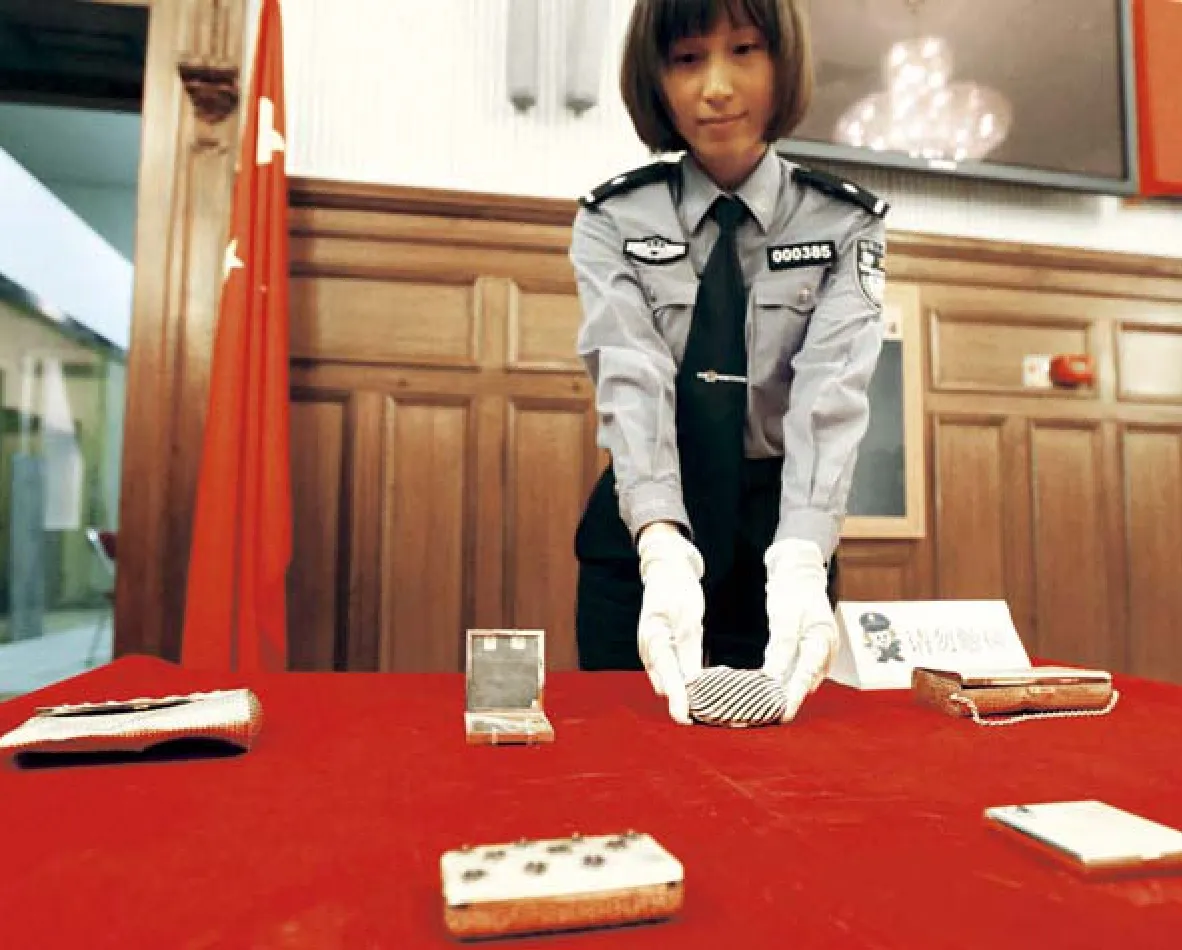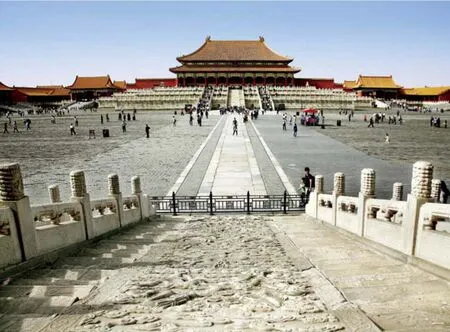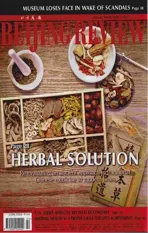Lost in Profits
2011-10-14YINPUMIN
Lost in Profits
The Palace Museum is swamped in criticism for failing to take care of precious national treasures
By YIN PUMIN
Last month, the Palace Museum in downtown Beijing, a World Cultural Heritage site recognized by UNESCO,was hit by a series of scandals.The Palace Museum, also known as the Forbidden City, is where Chinese emperors of Ming and Qing dynasties (1368-1911)resided from the early 15th century through the early 20th century.
On the night of May 8, nine gold and jewel art pieces on show at the heavilyguarded museum were stolen.
Several days later, news broke the museum had tried to turn its Jianfu Hall, which is composed of several buildings and a garden,into an exclusive club for the super-wealthy.
The negative news has aroused public concerns about the current situation of China’s historical relics, including their security and preservation.
Stolen dignity
The theft on May 8 is the fi rst in 20 years from the Palace Museum. On the night of May 11, the Beijing police detained a man who later confessed to the robbery.
The burglar, Shi Baikui, 28, from Caoxian County in east China’s Shandong Province, was caught 58 hours after the exhibits were stolen,the Beijing Municipal Public Security Bureau said in a news release.
Shi was believed to have dug through a temporary wall in the Zhai Gong, or Hall of Abstinence, at midnight on May 8, undetected by any of the anti-theft alarms and surveillance cameras located in the complex,said Ma Jige, Director of the Exhibition Department of the Forbidden City.
The stolen items were on loan from the Hong Kong-based Liangyi Museum, which had lent 19 pieces of wooden furniture and 111 Western-style purses and cosmetic containers to the Palace Museum for an exhibition from April 29 to June 27. “They are worth at least 30 million yuan ($4.61 million),” said Tracy Wong,Curator of Liangyi Museum.
At 8:20 a.m. on May 9, the nine items,gold purses and cosmetic containers embedded with jewels made between 1920 and 1945 including a Tiffany egg-shaped gold cosmetic container, were discovered missing. Two items were found later at the foot of a wall on the eastern side of the Palace Museum. Another four items were recovered after Shi was caught, but three pieces remain missing.
The Beijing police on May 17 offered rewards for people who return the missing items or provide tips on their whereabouts.
Feng Nai’en, Assistant Curator and spokesman for the Palace Museum, said at a news conference on May 11 the burglar had been spotted and questioned by a security guard in the museum at 10:30 p.m. on May 8, but he fled while the guard was calling the security of fi ce. For the rest of the night,police officers and more than 20 Palace Museum workers combed the entire museum looking for Shi without success.
Besides ordinary security measures, such as patrolling and technological means used by other museums, the Palace Museum also has a special force of more than 10 police dogs to safeguard the ancient imperial palace. The museum has a patrol crew of 240 people in eight guard divisions. After 4:30 p.m. every day,security guards empty the complex, checking every corner three times. At least 1,600 antitheft alarms, 3,700 smoke detectors and 400 surveillance cameras run day and night.
“Our work is certainly not thorough enough,” Feng said. “However, I hope that people will not lose confidence in Palace Museum security.”
There were media reports rumoring that alarms in the Palace Museum did not function during the robbery.
Feng said the museum was undergoing security overhauling security facilities in all its exhibition halls, storerooms and courtyards to find possible weaknesses and had intensi fi ed safeguards.
However, security experts argue hi-tech anti-theft systems alone do not make for a foolproof security system.
“All anti-theft systems are tools. You still need to depend on the industriousness of people who operate the system,” said Wang Dawei, a professor at the Chinese People’s Public Security University.
The theft from the Palace Museum raised concerns for other museums to introduce effective security systems consisting of trained guards and better surveillance equipment.
On May 11, the State Administration of Cultural Heritage ordered museums throughout the country to close temporarily to review their security protocols.
Shan Jixiang, Director of the State Administration of Cultural Heritage, said criminals were going after bigger targets,including artifacts listed on the UNESCO World Cultural Heritage list.
“Even though the Central Government has spent 150 million yuan ($21.96 million) to improve security, the country’s protection of its relics remains relatively poor,” Shan said, citing unskilled staff, outdated facilities and lax supervision as major problems.
In March, Shan submitted a proposal during the Fourth Session of the 11th National Committee of the Chinese People’s Political Consultative Conference, suggesting the state subsidize free-admissionmuseums for security enhancement and accident insurance for security guards.

(Left) A QUICK RETURN:A policewoman shows recovered gold purses that were stolen from an exhibition in the Palace Museum in Beijing on May 8
The proposal would sound more persuasive to lawmakers, said Wang Chao, a researcher at the Lu Xun Museum in Beijing.“The recent theft from the Palace Museum is not totally bad. At least security facilities and the administration of museums across the country are likely to be upgraded.”
Suspicious business
After coming under criticism for having poor security, the Palace Museum found itself in the center of a controversy again in mid-May.
The newest wave of criticism was triggered by a netizen, who wrote on the Internet that he had received an invitation letter to join a posh club in the Palace Museum after attending the unveiling ceremony of the rebuilt Jianfu Hall in March.
On May 11, Rui Chenggang, a news anchor at national broadcaster CCTV, disclosed on his micro-blog the Jianfu Hall had been converted into a private club that is open only to the rich and is so exclusive that no more than 500 people can obtain a membership.
Rui also said a foreign tourist guide even informed him a U.S. billionaire had just arranged to hold a dinner with his family in a building in the magni fi cent hall, even though that space is still closed to the general public.
The Jianfu Hall was ruined by a fire in 1923, and was rebuilt between 2000 and 2005 with $14 million donated by Hong Kong businessman Ronnie Chan. The garden of the hall, also known as the West Garden,was built in 1740 and was the second largest garden in the Palace Museum.
On May 13, the Palace Museum issued a statement, saying the Jianfu Palace is mainly used to receive domestic and overseas distinguished guests and hold lectures, seminars and press conferences. “It would be impossible to make it a private club,” said the statement.
But netizens immediately disclosed new evidence to the contrary the next day—photos of an agreement between the management of Jianfu Hall and members of the private club.
The agreement said club members, as well as their spouses and guests, could enjoy the privilege of holding banquets and conferences at the hall if they paid membership fees regularly.
The agreement was signed by the Forbidden City Cultural Development Co., a marketing unit of the Palace Museum. Since March, the company reportedly had posted advertisements soliciting chefs, waiters, bartenders and security guards.
On May 14, Rui said on his micro-blog obtaining the membership of the club in the Palace Museum cost at least 1 million yuan($153,800). “The total of 500 million yuan($76.90 million) in membership fees alone is fi ve times as much as the rebuilding costs of the Jianfu Hall,” Rui said.
The Palace Museum is a national treasure that belongs to all Chinese and should not be used for profit-making business operations, Rui asserted.
On May 16, the Palace Museum admitted that there was indeed a plan to convert a palace hall into a lucrative private club but said museum leaders knew nothing about it.
“The club was planned by the Forbidden City Cultural Development Co. without approval of the management of the Palace Museum,” said a statement.

NATIONAL TREASURE:The Taihe Hall in the Palace Museum in downtown Beijing
Liu Chaoying, Deputy Director of the Beijing Municipal Administration of Cultural Heritage, said for-pro fi t businesses should not operate in state-owned historical and cultural sites like the Palace Museum.
“You can find a restaurant or a cafe in every museum around the world, for example in the Louvre,” Liu said. “But, the eateries are meant to better serve the tourists and re fl ect the cultural characteristics of the site, not just to make money.”
“Public museums should serve the public, rather than individuals. The Palace Museum has gone against its code of ethics,”said Ma Zishu, Director General of the China Culture Relics Protection Foundation.
In fact, the apparently inappropriate use of cultural landmarks does not stop at the Forbidden City.
Another plan to convert an ancient palace site in the Chengde Mountain Resort into a luxury club has also been exposed.The resort is a royal complex of palaces and temples built in the Qing Dynasty (1644-1911) in Hebei Province.
“It is undeniable that the current system for the preservation of cultural relics has several loopholes,” said Gao Guoxi, a sociologist at Shanghai-based Fudan University,told Xinhua.
Gao said, in China, it is not rare ancient cultural relics were abused for economic gains.
An Jiayao, a researcher with the Institute of Archaeology at the Chinese Academy of Social Sciences, said although China had trumpeted its preservation of cultural relics in past decades, a lack of awareness of the significance of these relics had resulted in poor enforcement of relevant regulations.
